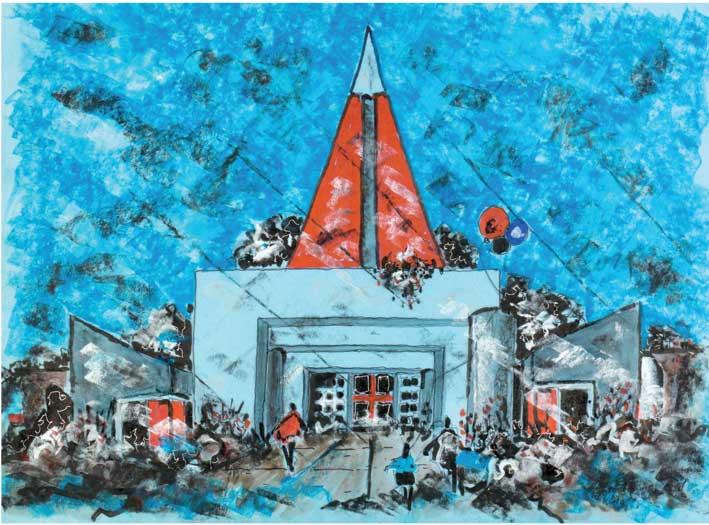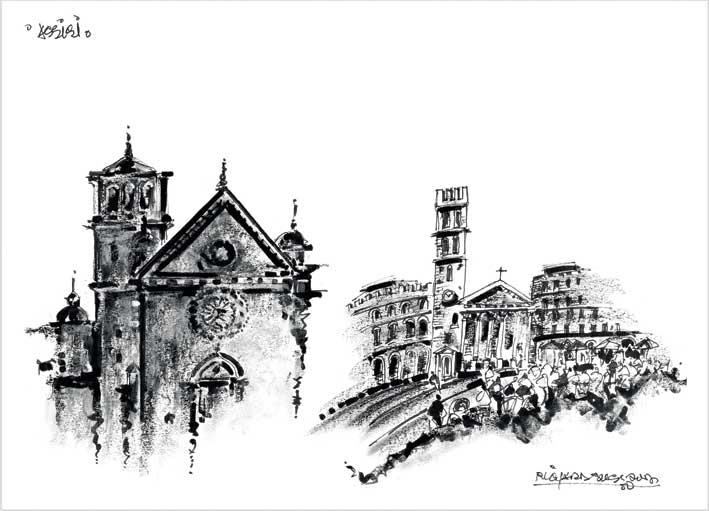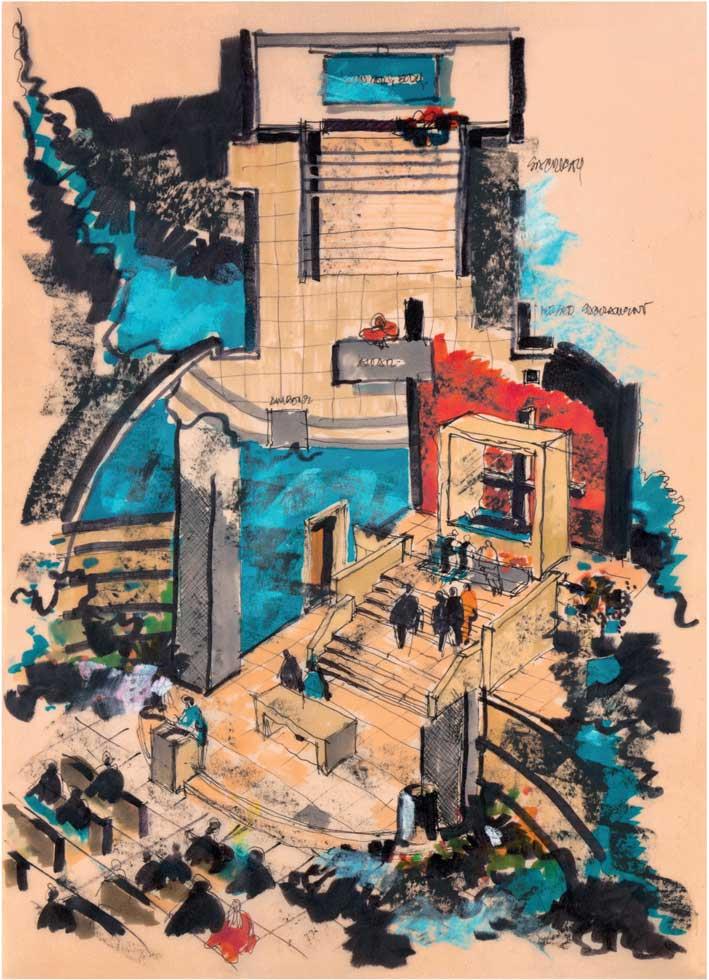I am going to limit myself here to quotes from the catalogue which say much more about the exhibition than I ever can.
In the Foreword Curator of the Museum, Joseph Farrugia writes: “…The architect and artist that he is, his life-long work has not only given the world a new definition of the ‘architect as artist’ but it has also enriched the Mediterranean construct into a visual concept depicted in the boldest expressions of contemporary art and the finest of pictorial poesy.”

Church of the Resurrection, Dar il-Ħanin Samaritan, Santa Venera, Malta
Chris Abel, who has taught and researched architecture in many countries and is the author of over one hundred published works, many of them translated into several languages, writes: “Familiar as the idea of the architect as artist is to architectural historians, in the case of Richard England’s work it is especially appropriate. Quite simply, no other description conveys the extraordinary range of England’s artistic achievements displayed in this exhibition… Along with the visual feast for the eye, the exhibition includes samples of his poetry, but not his other literary achievements – notably his unorthodox re-examination of the Biblical story of Cain as the first architect – nor his musical collaborations with the late Maltese composer Charles Camilleri, which lie outside the exhibition’s scope. Most important, what the work on display here demonstrates is that, beyond the restrictions imposed by social conventions, artistic imagination itself has no boundaries.”

Papal Pavillion, Floriana 2001
The prolific Giovanni Bonello needs no introduction. Suffice it to say that six books have been published about his life and his achievements, never mind that he has written or been principal editor of 35 books and has distinguished himself as judge in the European Court of Human Rights. I wish to quote at some length from his essay Saboteur of Mediocrity: “The Maltese islands have expressed astounding architects during the earliest glimmers of human prehistory – the Ġgantija temples in Gozo claim to be the oldest built structures in the whole world, followed immediately by the burgeoning of a spectacular megalithic civilisation in Malta. They thought big. They celebrated rational. They fashioned beautiful. That alone establishes how central to the concept of human creativity the urge to ‘build’ must have been in Malta and Gozo rather than, and before, anywhere else.

Church of St Joseph, Manikata
Yet despite this astonishing primacy in time and in place, our homeland had never given the world a named architect whose fame transcended the narrow boundaries of the islands’ territorial waters. Competent builders abound. Local celebrities are not lacking. But Girolamo Cassar, Tommaso Dingli, Lorenzo Gafà, Emanuele Luigi Galizia are purely local glories whose names, however competent and worthy, have limited resonance only within the confines of the islands.
It had to be Richard England who, for the first time in history climbed the platform of international architectural renown. The first and so far, the only. He sabotaged mediocrity.
England has now reached a ripeness where balance sheets are possible and called for. His amazing achievements and his undeserved defeats can now be placed in the proper perspective of a long, laborious and inspiring life-span. I see this Ħaġar exhibition as just one small but significant step in placing this balance sheet on more permanent record. It would be presumptuous of me to try to distil the essences of Richard England’s creativity in a few perfunctionary and possibly shallow words, Richard has been architect, painter, writer, lecturer, photographer, sculptor, profound thinker, aesthete. To his credit is also the creation of at least two important art hubs for corporate entities – the Central Bank and the many Mid-Med Bank branches, now HSBC. Overall, he will be remembered as an explorer of the spirit, manically obsessed by the hunt for the poetry of existence, the infallibility of beauty…



He has hounded the essentials of splendour in the design of his buildings, in the structure of his writings, in the stains of his drawings. His buildings I see as poems in stone or concrete. He is the one contemporary architect who can turn the humblest sacred spaces into cathedrals of the spirit. His evocative and highly personalised meshings of colour, light, line and geometric volume have been his insignia and his fingerprint. A mystic dimension never absents itself from England’s hallowed spaces, but equally from his other constructs, his poems, his graphic art.

San Gorg Preca Tomb
England found inspiration in the essential, humble and timeless message of the functional vernacular. Richard revealed to me that it was my father’s foresight and determination that pressurised the ultra-conservative church authorities to green-light his first and fundamental experiment in the new idiom, the perennially ageless Manikata church. It took reckless heroism on the part of a fledgeling graduate in architecture to even dare submit that concept in the sixties. England remains the insuppressible poet even in his apparent contradictions. His architectural ethos is anything but baroque – I believe he abhors the often vacuous prettiness of busy decoration for its own sake. Yet his graphic renditions of the existing baroque heritage of Malta and Gozo – see his ‘Churches of Gozo’ – are masterpieces of draughtsmanship of baroque imagery seen through the eyes of a poet and a mystic. Epic poet in his major buildings, lyrical where intimacy demanded it, metaphysical in the concepts that still gurgle in his restless mind…
I asked Richard what he would like his testament to sound like. He had few hesitations: I believe architects should not only be the designers of the future but also the defenders of the past. I dread the fact that computer technology might still have the mouse eat the pencil. I believe that the bridge between mind and paper is still crossed by the hand. End of a pregnant, programmatic quote and the beginnings of the heritage of an incremental dream.”
In his essay The Spirit of Place John T. Spike, also very well known as an art historian, museum curator, author of more than 20 books and lecturer writes: “In this exhibition, the drawings are of many kinds and techniques, too many to describe one by one. Despite their differences, that might seem at first, to indicate different hands they are unified by their concentrated focus on architecture, cities, the planning of buildings and study of them, and even the morphing of them, with pen and ink, into surrealities i.e. fantasies. They can be exuberant or meticulous, airborne or embedded in the raw earth. The Mythopoli series explores the imaginations of science fiction writers from Jules Verne to Jorge Luis Borges and includes some of England’s most creative and most intense, drawings of architecture. Hovering on the white page like fantastic constructions of a thousand tiny towers, they resemble mystical Mandalas of infinite power. Among the Italian drawings re-drawn during the 2020-21 lockdown, Assisi, a town I know well, here appears curved around an open space like a special theatre for an audience of buildings, all under the watchful eye of a darkened moon… “
In his comment The Pen as Voice of the Mind Ian Ritchie, another international architect and artist and author of several books, writes thus: “To be gifted is to be blessed, but the gifts that we receive have to be used for the benefit of others as much as they are an outward expression from our inner self.
To capture the sense of place and its importance to the collective memory is what Richard has given through his imagination and drawings to the people of his beloved islands of Malta and Gozo. They are exceptional.
In Richard’s hands his pen becomes the voice of the mind, his love and concern for the man-made in the world built in harmony with nature and nature’s own laser light pen, the sun. Through indelible lines of black ink and by leaving the white of the paper as light, he conjures such striking compositions of form with his unique eye for urban perspective.
His work is both art and document, a beautiful voice of constancy in an age where capital has disturbed and distorted man’s thoughts and actions so much.
Richard’s oeuvre reminds me of Shakespeare’s sonnet number 65 ‘To love’, where both love and beauty are so precious yet also so fragile, and yet, optimistically he captures in the last line that hope of eternity.”
THE EXHIBITION
The 80 items on show include architectural photos, concept drawings, designs and sketches, the ‘Viaggio in Italia’ and the ‘Mythopoli’ collections, interpretations of the Victoria Citadel and other aspects of Gozo. Also on display are stamp designs supported with a special philatelic folder.
The exhibition remains open at Hagar Museum until 18 April. Entrance is free.
Hours of opening: Monday to Sunday from 9am to 5pm. You may also wish to consult the Museum’s Facebook page.
This commemorative folder was produced in connection with the Richard England: Architect as Artist exhibition at Il-Ħaġar. It includes two sets of postage stamps which Richard England had designed in 1975 and 1987; a print by Richard England of the Basilica of San Gorg in Victoria and a MaltaPost personalised stamp and cancellation hand stamp. The folder is issued in a limited number (100) with proceeds going to Il-Ħaġar Museum.
SAVE MALTA MANIFESTO 1970 - RICHARD ENGLAND
Each day in Malta, new stones are cut from this rock, new concrete structures dry in the sun; new villas, apartments and hotels are developed, and still there is not enough room for the visitors who come. Malta cannot however stand still; she must change, though she must ensure that the change is in the right direction. These cities, towns, villages, fortresses and walls must certainly be open to absorb this new prosperity, if Malta is to survive economically. But Malta must also survive on another level is she is to survive at all – as a total environment, as a homogeneous entity, as a particular heritage handed down over generations.
Yet it is this very quality which we see threatened. Mediaeval skylines are being destroyed by oversize structures. In the name of progress and to accommodate the motorcar the heart is torn out of the villages, church enclosures are violated and calculated spaces relating specifically to man are breached, broken and destroyed. These closely knit environments of a different age can now be utilized very effectively as pedestrian precincts within the frame-work of modern town planning concepts which require segregation, pedestrian from motor traffic.
Handled with sensitivity, the growth of the new Malta need in no way conflict with the old. With careful planning, a balance and harmony can, and must, be achieved. Politicians, Architects, Developers, Citizens of Malta, Visitors of Malta, we appeal to you together; before it is too late; guard this European heritage in all Malta; watch over its spontaneous but piecemeal growth, organize it, relate it to its surroundings; respect the spaces over centuries. Modern structures, hotels, even whole villages can, with due skill, care and scale relationship be fitted well into this old landscape.
This Manifesto supports valid contemporary architectural and planning solutions, on the other hand it strongly opposes dangerous aesthetic regressions or any form of cliché-ridden revivalism. Maltese, guard Malta in trust for your children, for it is the testament of five thousand years of human habitation. It is our solemn duty as citizens of Malta to fight against its desecration, and all of us, in Europe, and the World, let us join together to save this unique architectural environment.
For Malta is stricken, and time is against us.